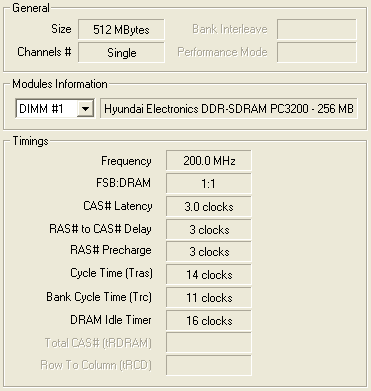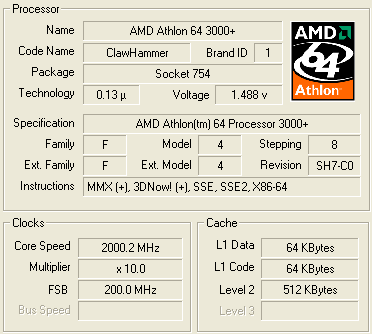System Setup and Notes
Rather than show BIOS shots, I'll let CPU-Z do the talking as far as memory timings and BIOS setup is concerned. Being a VIA K8T800 based motherboard, Evesham had wisely set DDR400 memory speeds and SPD BIOS timimgs for the memory modules, along with 800MHz HT/LDT bus clock.CPU-Z shows 3-3-3-14 shipping memory timings.

Hyundai turn out to be the module vendor, the data read from the SPD EEPROM on the modules themselves.
CPU-Z also confirms we're running an Athlon 64 Model 3000+ @ 2GHz with 512KB of L2 cache memory. Click the CPU-Z screenshot for a picture of the CPU itself.

Finally before we move on to the formal spec, click here for a look at the motherboard properties. Note the Evesham branding as the board manufacturer, something you don't usually see, along with the BIOS date of 04/02/01, a curious date that seems to be a result of Evesham's customisations.
Hardware
- Evesham Axis 64 3000+
- Evesham Axis 64 3200+
- HEXUS 3.2GHz P4, i865PE, Radeon 9800SE AIW comparison system
Software
- Windows XP Home w/SP1 and current Windows Update patches (Evesham systems)
- Windows XP Professional w/SP1 and current Windows Update patches (HEXUS system)
- ATI CATALYST 3.9 and control panel (all systems)
- VIA Hyperion 4.42 (Axis 3000)
- VIA Hyperion 4.49v2 (Axis 3200)
- Intel 5.00.1015 chipset drivers (HEXUS system)
- DirectX 9.0b Runtime
- 3DMark 2001SE v330
- Realstorm 2003 Raytracing Benchmark
- LAME 3.92MMX MP3 encoding (U2's Pop album to 192kbps CBR)
- HEXUS Pifast benchmark
- Sciencemark 2.0 (Primordia test w/Ag)
- Unreal Tournament 2003 (HEXUS Custom Suntemple Low Detail demo)
- X2: The Threat Rolling Demo
Support Notes and Value For Money
To test value for money, an extremely similar system was priced up at a popular UK online retailer. The only shipping difference is that the online retailer doesn't carry the LG monitor, a comparable Hyundai was used instead. Software and hardware parts were all accounted for, even the Chenbro Gaming Bomb case that Evesham customise with their own logo, was used. The total sum of all parts at the store was £1133 including dreaded VAT. With the Evesham retailing at £999.99 + VAT (£1175 inc), that's a £42 difference.The Evesham ships with their standard 3yr warranty. The first two years are on-site, all parts and labour are included, the third year is return to base and they should cover collection and redelivery costs for you, although it's worth checking that before buying. With a delivery charge of £39 to add on top of the £1175, the Axis 64 3000+ tips the scales at £1214, a near £100 difference. However when you factor in the warranty cost, things are almost equal.
In terms of value for money, the Evesham respresents a good buy. The 2 year on-site warranty period with all parts and labour costs included make it worth your while to buy from Evesham, rather than build the PC yourself. It's a close cut thing, margins in this sector of the market make things tight for everyone, but we'll give Evesham the benefit of the doubt.
Usage Notes
The system was as stable as the proverbial rock when doing CPU and system based tests. However a slightly loose heatsink on the Radeon 9800SE meant that VPU recover would show its face all too often when things got toasty. That was the only anomaly worth reporting. The Axis 64 made it through all the graphics tests eventually and Evesham say that it was a solitary defect, probably caused during shipping, since all systems are pre-tested before they leave the warehouse. Of course the warranty on the system would have it replaced in quick smart time, if it happened to you. An isolated problem but one we must report.Benchmark Notes
As always, benchmarks are run three times for consistency in results, with the top and bottom results discarded and the median result used in the graphs. Feel free to hit our discussion forums to ask us about the tests.For this system review, to keep consistency with recent Evesham and MESH system reviews, all graphical benchmarks were run at 1280x1024, rather than the usual 1024x768.









